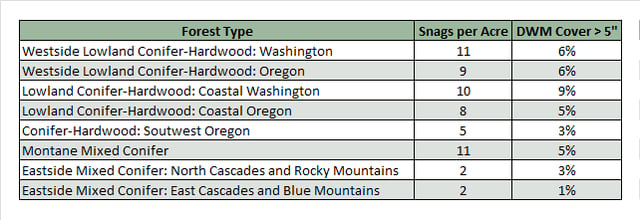
Forest Biomass Retention and Harvesting Guidelines for the Pacific Northwest are specific to Oregon and Washington and based on best practices for eight distinct forest types:
- Subalpine and fir-spruce
- Klamath-Siskiyou mixed conifer
- East Cascades & Okanogan Highlands mixed conifer
- Coast Range & Western Cascades Doug-fir hemlock
- Coastal forests
- Oak woodlands
- Juniper woodlands
- Eastern ponderosa pine
The report recommends guidelines for biomass retention and harvesting that will help maintain optimal soil and water conditions, wildlife habitat, and fuel loads.
Downed Woody Material
The first guideline specifies the types and amounts of biomass that should be left on site in order to maintain soil fertility and wildlife habitat after a harvest. The Guild refers to this biomass as downed woody material (DWM). The amount of DWM left on the ground, will vary along with site-specific conditions and management objectives. For example, tracts characterized by nutrient-poor soil, small quantities of DWM, and subject to frequent harvests will require more DWM remain than those lands with nutrient-rich soil, plenty of DWM and that undergo few harvests.
The quantity of available DWM also fluctuates as stands develop. Accordingly, the goals set forth by the guidelines may not apply to all harvests, but they can support the development of long-term management goals. For the purposes of biomass harvest guidelines, the Forest Guild report refers to DWM to as any combination of coarse woody material (CWM), fine woody material (FWM) and large woody material (LWM):

The Forest Guild supports Oregon State University recommendations to retain at least 30 percent of FWM on slopes favorable to ground-based harvesting and 50 percent or more on the steeper slopes where Doug-fir grows. When small mammal protection is a management objective, the report advises leaving 15-20 percent of CWM on the ground in western Washington and northwest Oregon and 10 percent or more CWM cover in southwestern Oregon’s Doug-fir forests.
The availability of different species of dead wood in different stages of decay is also important to wildlife. The guidelines note snags greater than 14 inches diameter at breast height (DBH) are used by the majority of wildlife species, although one third of species prefer snags more than 29 inches DBH. Recommendations for snags and DWM cover set forth in the report are as follows:

Benefits
Protecting Rare Ecosystems and Sensitive Sites
The Guild acknowledges biomass harvests are appropriate for rare and sensitive ecosystems like old-growth stands as long as ecological standards remain at the forefront of the management objectives. When performed correctly, the report suggests such harvests can control invasive species, improve wildlife habitat and restore site hydrology. The Departments of Fish and Wildlife in both Washington and Oregon have established criteria to help identify sensitive area that may require special consideration during harvest.
Soil Quality
CWM, FWM and foliage replenish soil nutrient pools. Low-impact logging techniques such as directional felling, skid trail layout, and the use of slash to protect soil on skid trails are also recommended to minimize compaction. To manage conflict between soil compaction and recovering harvest slash left in the forest, the Guild recommends allowing harvest slash to dry before piling or removing, encouraging needles and branches to fall in as uniform a distribution as possible across the harvest site. Others recommend traditional forest operations that integrate biomass removals to reduce soil compaction caused by re-entering stands.
Water Quality
Leaving biomass onsite aids in the prevention of erosion; it also can slow the rate of runoff by creating debris dams. Leaving snags and large downed logs in riparian zones is especially important in the Northwest, as previous stream channel management decisions reduced this material below desirable levels.
Fire and Fuel
Due to land-use changes and management and harvest regimes that have diverged from historical practices, many forests in the Northwest are overstocked; these forests carry uncharacteristically high fuel loads and represent significant fire threats. Treatments designed to reduce the severity of wildfire – specifically the reduction of ladder fuels and small-diameter trees – offer another opportunity to harvest biomass. When managing to reduce fire risks, a balance between biomass retention and the reduction of surface fuels must be struck. The guidelines recommend moderating this potential conflict by focusing retention efforts on creating discontinuities in the fuel through practices such as thinning.
Retention of Wildlife and Biodiversity
Biomass retention should be balanced between dispersed and clumped in order to attract the widest range of wildlife. Rodents, rabbits and hares, for instance, prefer slash piles and American martens prefer dense accumulations of logs for hunting and shelter. Other species benefit from wide dispersal of biomass as it covers a larger area.
Overall, biomass retention and harvest are equally important to the overall health of the forest; as such, the biomass harvest guidelines developed by the Forest Guild prioritize the condition of the forest after a harvest. Following such guidelines will help ensure our forests continue to sustainably supply biomass in a way that supports both economic and ecological goals.




